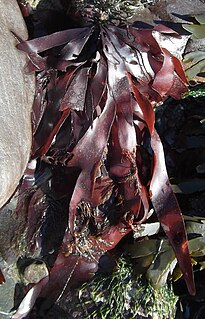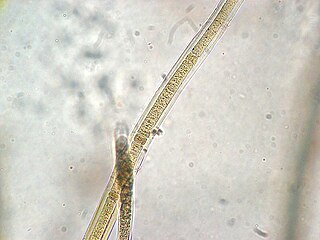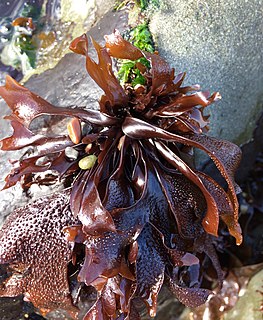
Palmaria palmata, also called dulse, dillisk or dilsk, red dulse, sea lettuce flakes, or creathnach, is a red alga (Rhodophyta) previously referred to as Rhodymenia palmata. It grows on the northern coasts of the Atlantic and Pacific Oceans. It is a well-known snack food. In Iceland, where it is known as söl, it has been an important source of dietary fiber throughout the centuries.

Oscillatoria is a genus of filamentous cyanobacterium which is named after the oscillation in its movement. Filaments in the colonies can slide back and forth against each other until the whole mass is reoriented to its light source. It is commonly found in watering-troughs waters, and is mainly blue-green or brown-green. Oscillatoria is an organism that reproduces by fragmentation. Oscillatoria forms long filaments of cells which can break into fragments called hormogonia. The hormogonia can grow into a new, longer filament. Breaks in the filament usually occur where dead cells (necridia) are present. It occur in fresh water ponds. Oscillatoria uses photosynthesis to survive and reproduce. Each filament of oscillatoria consists of trichome which is made up of rows of cells. The tip of the trichome oscillates like a pendulum. in reproduction, it takes place by vegetative means only. Usually the filament breaks into a number of fragments called hormogonia. Each hormogonium consist of one or more cells and grow into a filament by cell division in one direction.

Chlorococcales is an order of green algae in the class Chlorophyceae. Individual specimens are sometimes found in soil, but mostly in fresh and marine waters. The order contains approximately 780 species.
Chlamydopodium is a genus of green algae in the family Characiochloridaceae.
In taxonomy, Mychonastes is a genus of green algae, specifically of the Chlorophyceae.
Nemoderma is the only genus in the family Nemodermataceae and order Nemodermatales of the brown algae. The genus contains only a single species, Nemoderma tingitanum.

Scytonema is a genus of photosynthetic cyanobacteria that contains over 100 species. It grows in filaments that form dark mats. Many species are aquatic and are either free-floating or grow attached to a submerged substrate, while others species grow on terrestrial rocks, wood, soil, or plants. Scytonema is a nitrogen fixer, and can provide fixed nitrogen to the leaves of plants on which it is growing. Some species of Scytonema form a symbiotic relationship with fungi to produce a lichen.

Planktothrix is a diverse genus of filamentous cyanobacteria observed to amass in algal blooms in water ecosystems across the globe. Like all Oscillatoriales, Planktothrix species have no heterocysts and no akinetes. Planktothrix are unique because they have trichomes and contain gas vacuoles unlike typical planktonic organisms. Previously, some species of the taxon were grouped within the genus Oscillatoria, but recent work has defined Planktothrix as its own genus. A tremendous body of work on Planktothrix ecology and physiology has been done by Anthony E. Walsby, and the 55.6 kb microcystin synthetase gene which gives these organisms the ability to synthesize toxins has been sequenced. P. agardhii is an example of a type species of the genus. P. agardhii and P. rubescens are commonly observed in lakes of the Northern Hemisphere where they are known producers of potent hepatotoxins called microcystins.
Trichodesmium thiebautii is a cyanobacteria that is often found in open oceans of tropical and subtropical regions and is known to be a contributor to large oceanic surface blooms. This microbial species is a diazotroph, meaning it fixes nitrogen gas (N2), but it does so without the use of heterocysts. T. thiebautii is able to simultaneously perform oxygenic photosynthesis. T. thiebautii was discovered in 1892 by M.A. Gomont. T. thiebautii are important for nutrient cycling in marine habitats because of their ability to fix N2, a limiting nutrient in ocean ecosystems.

Mastocarpus papillatus, sometimes called Turkish washcloth, black tar spot, or grapestone is a species of red algae in the family Phyllophoraceae. It is sometimes confused with the distantly related Turkish towel which is of a similar texture but larger. The specific epithet papillatus is due to the nipple-like projections on the female gametophyte which can give the texture of a terrycloth washcloth found at a Turkish bath.
Anathece is a genus of cyanobacteria belonging to the family Synechococcaceae.
Eucapsis is a genus of cyanobacteria belonging to the family Merismopediaceae.
Dolichospermum flosaquae is a species of cyanobacteria belonging to the family Aphanizomenonaceae.
Chlorolobion is a genus of algae belonging to the family Selenastraceae.
Cuspidothrix is a genus of cyanobacteria belonging to the family Nostocaceae.
Heteroleibleinia is a genus of algae belonging to the family Pseudanabaenaceae.
Lemmermanniella is a genus of cyanobacteria belonging to the family Synechococcaceae.





